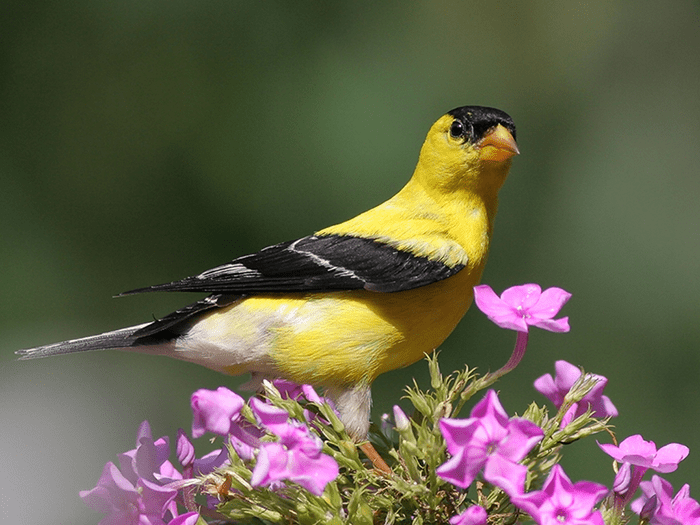
New Jersey is a northeastern U.S. state whose terrain consists of highlands, Appalachian ridge and valley, Newark basin piedmont, inner coastal plain, and outer Coastal plain. The capital of the state is Trenton. It’s a smaller state with a population of 9.267 million and an 8,722 sq mile size. But what are the most common birds of New Jersey?
In this article, you’ll find all the necessary birding information about New Jersey, including most common birds in New Jersey.
Most Common Birds of New Jersey
Based on North America Breeding Birds Survey, these were the most common birds in 2021 that you can actually see.
European Starling
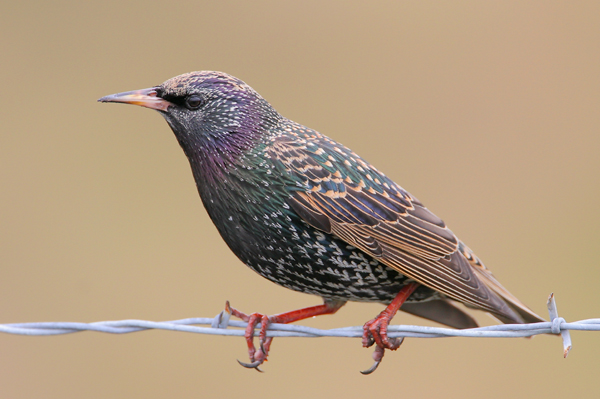
Photograph © Greg Lavaty.
The European Starling is a blackbird-sized chunky bird with a slender, long beak and short tail. Their short and pointed wings can be seen when in flight, making them look like small, four-pointed stars. This is where they get their name from!
From a distance, European Starlings look black, but when you take a closer look in good lighting, you can see purplish-green iridescent in their plumage and yellow beaks. In the winter, their plumage can look duller. They’re usually brown and have bold white spots.
European Starlings will consume almost anything; however, they focus on invertebrates like insects when they’re readily available. Common prey includes beetles, grasshoppers, caterpillars, flies, and earthworms.
They’ll also eat fruit like holly berries, wild and cultivated cherries, hackberries, and sumac. European Starlings have even been seen consuming livestock feed, seeds, grains, garbage, and nectar.
American Robin
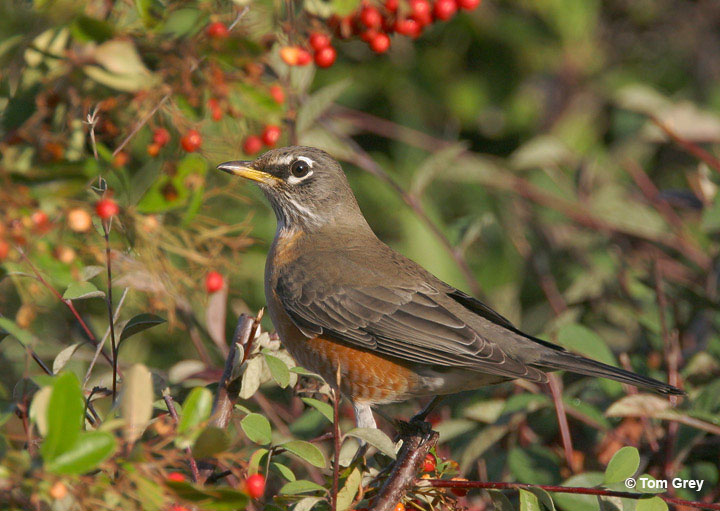
© Tom Grey
American Robins are relatively large songbirds with rounded, large bodies, rather long tails, and long legs. They’re the largest thrush in North America.
American Robins are gray-brown overall, have dark heads, and are warm orange on their underparts. When in flight, a white patch can be seen under their tails and lower bellies. Females look similar to males but have paler heads that contrast less with the gray back.
Robins consume large amounts of both fruit and invertebrates. In the spring and summer months, they eat large quantities of insects, snails, and earthworms. They’ve also been recorded eating aquatic insects, small snakes, and shrews, but this is rare.
In New Jersey, you can see them eat some hawthorn, chokecherries, sumac fruits, dogwood, and juniper berries too. One study stated that robins may try to round out their diet by eating fruits infested with bugs.
Common Grackle
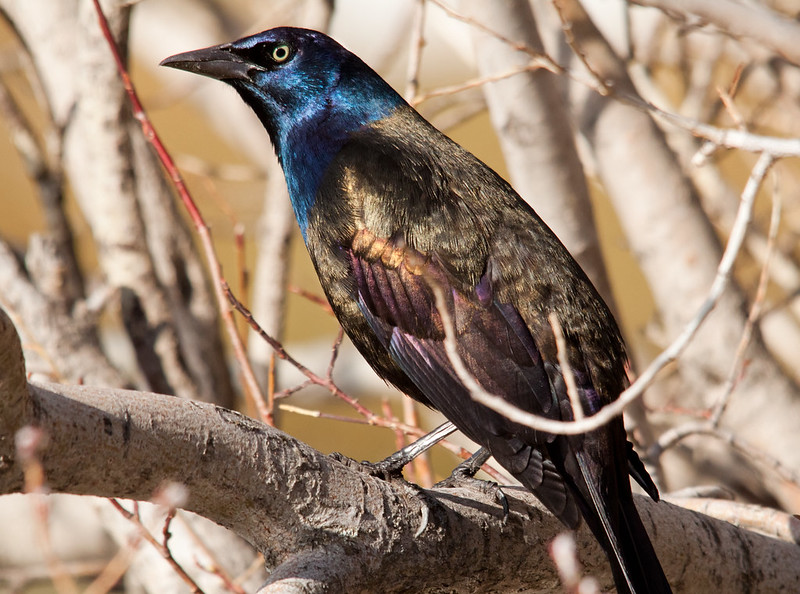
© Shawn McCready
Common Grackles are lanky yet large blackbirds that have long tails and long legs. Their heads are flat, and their bills are longer than most blackbirds. Additionally, their bills have a slight downward curve. When in flight, the wings look short in comparison to the tail.
From a distance, Common Grackles appear to be entirely black. However, if you can get a closer look in good lighting, you’ll see that these birds have glossy purple heads and bronzy-iridescent bodies. Additionally, they have bright golden eyes that give them an intent expression. Females are a little less glossy than males, and juveniles have dark eyes and are dark brown overall.
Common Grackles mainly eat seeds. They particularly love agricultural grains like rice and corn. Other foods they’ll consume include acorns, sunflower seeds, and tree seeds. In the summer months, a quarter or more of these birds’ diets may include animals like spiders, beetles, caterpillars, grasshoppers, crustaceans, fish, mollusks, and frogs.
Gray Catbird
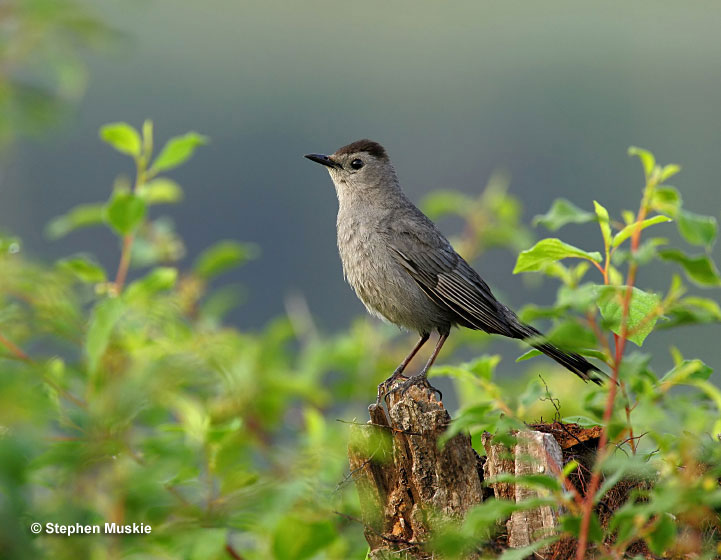
The Gray Catbird is a slender, medium-sized songbird that has a rounded, long, black tail and a straight, narrow bill. Catbirds have relatively long legs and have rounded, wide wings. They’re a little bit smaller than a Northern Mockingbird.
Gray Catbirds look completely slaty gray. However, when you take a closer look, you’ll see they have small black caps, a rich rufous-brown patch under the tail, and overall blackish tails.
In the summer months, Gray Catbirds primarily eat beetles, ants, grasshoppers, moths, caterpillars, and midges. However, when fruit is available, they’ll also eat cherries, holly berries, elderberries, and blackberries. They can be garden pests because of how much they love fruit. They’ve been known to damage and consume strawberries, raspberries, grapes, and cherries.
Mourning Dove
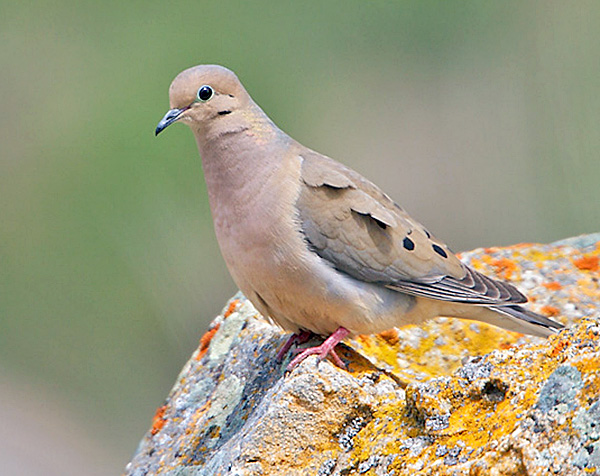
Photograph © Greg Lavaty.
Mourning Doves are unique in that they have pointed, long tails that are unlike all other North American doves. Additionally, they have plump bodies, short legs, heads that look small compared to the rest of their body, and small bills.
Mourning Doves tend to blend in with their surroundings exceptionally well. They’re a delicate buffy-tan to brown overall, have black spots on the wings, and white-tipped tail feathers that are bordered with black.
Mourning Doves mostly eat seeds; in fact, they make up 99% of their diet. They love peanuts and cultivated grains, as well as weeds, wild grasses, herbs, and sometimes berries. They’ve even been seen eating snails, but this is rare. Mourning Doves eat around 12 – 20% of their body weight every day. That’s an average of 71 calories.
Red-winged Blackbird
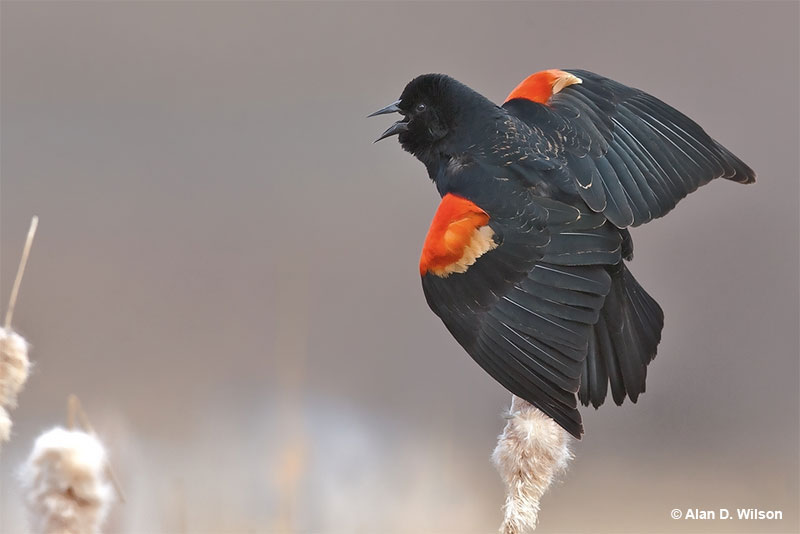
The Red-winged Blackbird is one of the most common birds of New Jersey. It is a broad-shouldered, stocky blackbird with a slim, conical bill and a medium-length tail. When they’re perched, these birds have a hump-backed silhouette, and males usually sit with their tails slightly flared. Red-winged Blackbirds are about the same size as a Common Grackle.
Male Red-winged Blackbirds are not easy to mistake. They have red-and-yellow shoulder badges and are glossy black overall. Female Red-winged Blackbirds have crisp streaks and are dark brown overall. Additionally, they have whitish eyebrows and are paler on the breast.
Blackbirds primarily eat insects in the summer and seeds in the winter. They can sometimes be seen feeding by probing the bases of aquatic plants with their bills. They’ll pry them open to get any insects that may be hiding inside. In the fall and winter months, they eat seeds from weeds such as cocklebur and ragweed, as well as waste grains and native sunflowers.
Chipping Sparrow
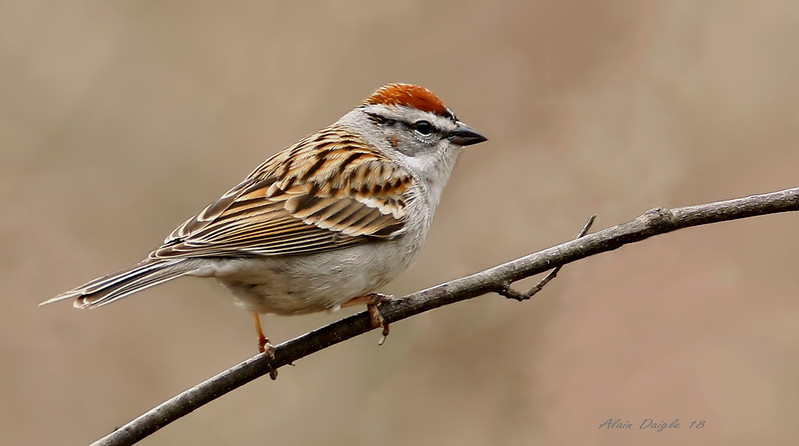
© Alain Daigle
The Chipping Sparrow is a slim yet relatively long-tailed sparrow. They have medium-sized bills that are a bit small for a sparrow. Chipping Sparrows are trimmer, smaller, and have shorter tails than a Song Sparrow. They’re a little bit larger than a chickadee.
In the summer, Chipping Sparrows have a crisp and clean look. They have pale faces, frosty underparts, black lines through the eyes, and bright rusty crowns. In the winter, Chipping Sparrows are duller. They have dark streaks on their upper parts and are buff-brown overall. However, the black lines through the eyes are still visible, and the cap is a more subdued rusty color.
Chipping Sparrows primarily consume seeds from a wide variety of herbs and grasses. During their breeding season, they hunt for protein-rich insects as well. Sparrows have also been known to occasionally eat small fruits.
Laughing Gull
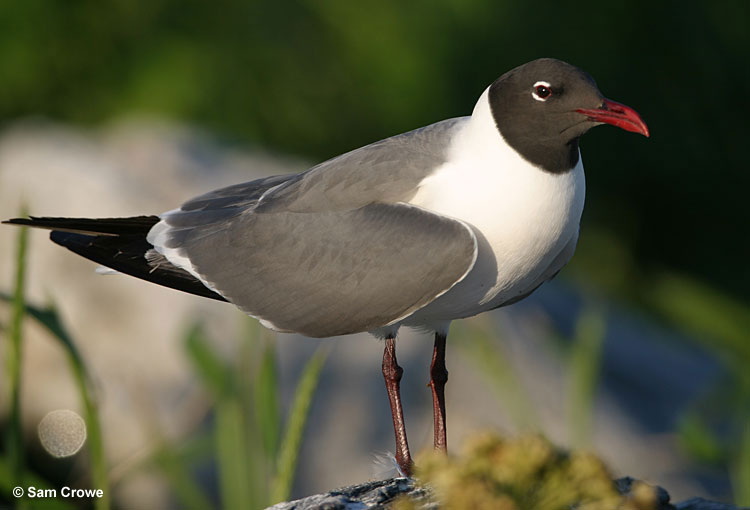
The Laughing Gull is a medium-sized gull with long legs and relatively long wings. Additionally, they have fairly long, stout bills. Laughing Gulls are a little bit smaller than a Ring-billed Gull.
Laughing Gulls are white below and medium gray above. In the summer, adults have a clean black hood, reddish bills, and white arcs around the eyes. In the winter, the hood becomes a blurry gray. No matter the season, their legs are reddish black to black. Immature birds are browner and have more subtle patterns.
Like most gulls, Laughing Gulls eat a wide range of foods. They eat a lot of invertebrates, including insects, earthworms, snails, crab eggs, crabs, fish, berries, and squid. In addition, they occasionally eat other birds’ eggs.
Northern Cardinal
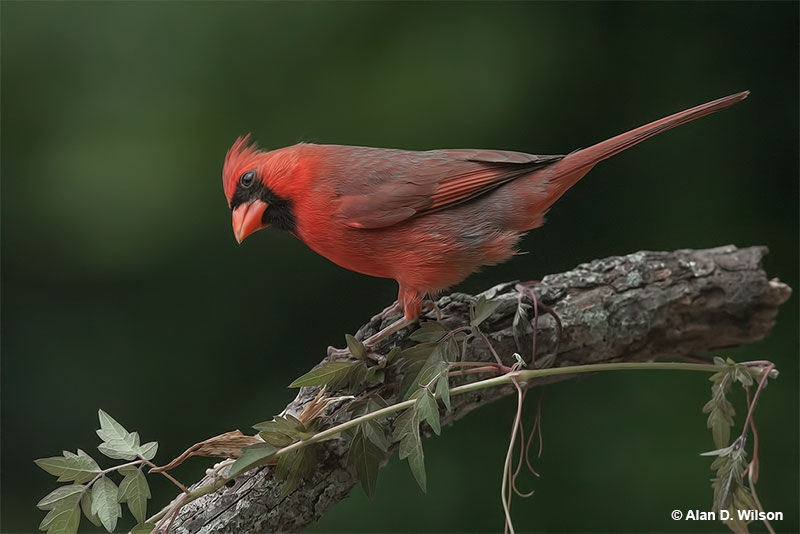
The Northern Cardinal is a long-tailed, fairly large songbird that has a prominent crest and very thick, short bills. Cardinals can be seen with a hunched-over posture and their tail pointed straight down.
Male Northern Cardinals is one of the most common birds of New Jersey (and in other states). They have bright red overall and have reddish bills that are surrounded by a black face. Female Northern Cardinals are pale brown all over and have warm reddish tinges in the crest, tail, and wings. They have the same red-orange bill and black face.
Cardinals generally eat fruit and seeds. They’ll supplement their diet with insects. Common seeds and fruits they consume include wild grape, dogwood, buckwheat, sedges, grasses, mulberry, blackberry, and sumac.
Cardinals love to visit backyard bird feeders and will consume a variety of seeds. However, they especially love black oil sunflower seeds. They’ll also consume crickets, beetles, cicadas, flies, spiders, moths, and butterflies.
House Sparrow
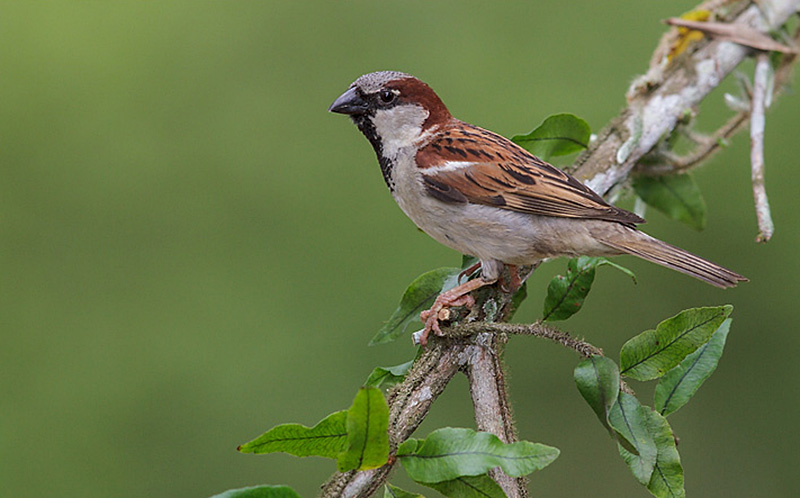
House Sparrow (Passer domesticus) perched on a branch in the Atlantic rainforest of southeast Brazil.
The House Sparrow is a chunky, fuller-chested, round-headed, shorter-tailed sparrow. Additionally, they have stouter bills than the majority of American sparrows. These birds are about the same size as a Song Sparrow.
Male House Sparrows are brightly colored. They have rufous necks, gray heads, black bibs, and white cheeks. Female House Sparrows have dull gray-brown underparts and are plain buffy-brown overall. Their backs are noticeably striped with brown, black, and buff.
These sparrows commonly consume seeds and grains, as well as livestock feed. In cities, they’ll also take advantage of discarded food. The crops they eat include oats, corn, sorghum, and wheat. Wild foods they consume include buckwheat, crabgrass, and ragweed. House Sparrows also have no trouble eating birdseed like milo, sunflower, and millet seeds. House Sparrows consume insects in the summer months and feed them to their babies.
Song Sparrow
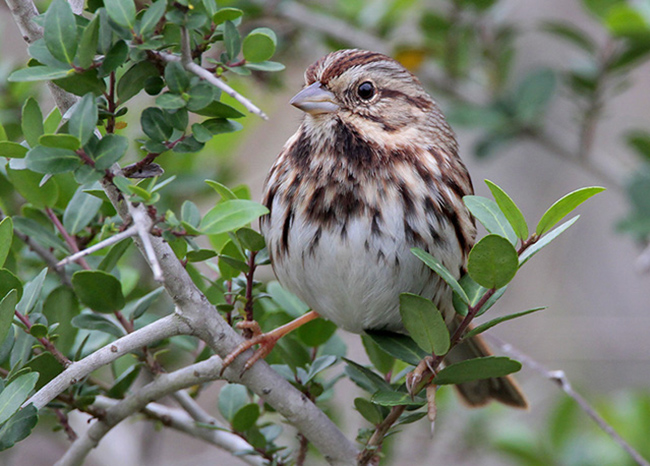
The Song Sparrow is a relatively bulky, medium-sized sparrow. Their heads are fairly round, and their bills are stout and short. Additionally, their wings are wide, and their tails are rounded and long. They are a little bit bigger than a Chipping Sparrow.
Song Sparrows are brown and have thick streaks on their white flanks and chests. When taking a closer look, you can see their heads have an attractive mix of salty gray and warm red-brown. However, it’s important to note that these shades and amount of streaking will vary extensively across their range.
Song Sparrows consume fruits and seeds year-round and insects and other invertebrates in the summer months. Some of the prey they’ll consume include leaf beetles, ground beetles, caterpillars, grasshoppers, spiders, earthworms, and snails. Plant foods they consume include ragweed, clover, wheat, sunflower, rice, blueberries, blackberries, strawberries, raspberries, and wild cherries.
House Wren
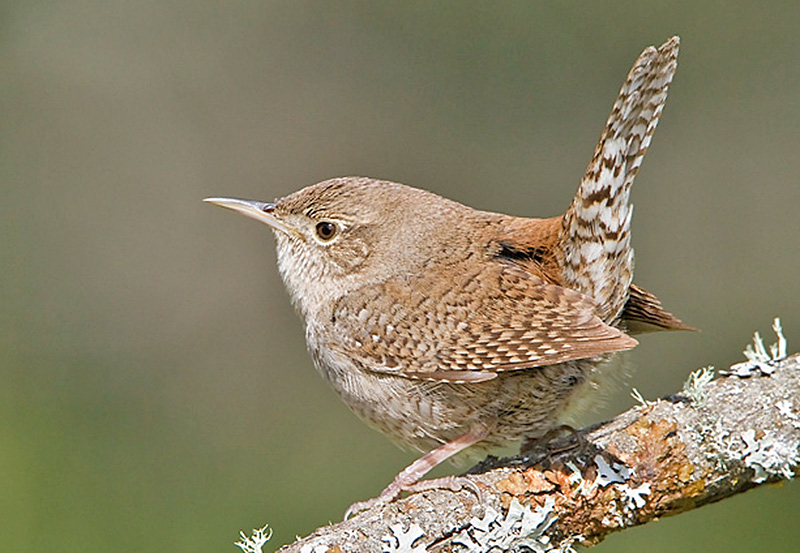
Photograph © Glenn Bartley.
The House Wren is compact and small. They have relatively long, curved beaks and flat heads. Their wings are short and usually keep their long tails slightly drooped and cocked above their body. House Wrens are chickadee-sized.
House Wrens are brown overall and have darker barring on their tails and wings. In addition, they have the characteristic pale eyebrow that so many wren species have. However, it’s much fainter in these birds compared to others.
House Wrens eat a wide variety of spiders and insects, including caterpillars, beetles, earwigs, and daddy longlegs. They’ve been known to consume smaller amounts of flying insects, such as springtails, leafhoppers, and flies. Additionally, House Wrens will consume snail shells. It’s theorized that this gives them the necessary calcium they need, and they also provide grit to aid in digestion.
Ovenbird
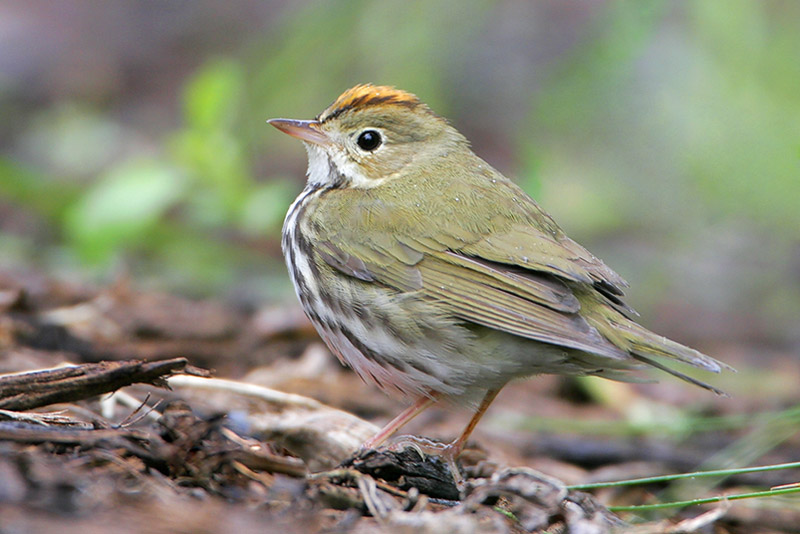 The Ovenbird is a larger-than-average, chunky warbler. They have round heads, relatively thick bills, and tails that are often cocked upwards.
The Ovenbird is a larger-than-average, chunky warbler. They have round heads, relatively thick bills, and tails that are often cocked upwards.
Ovenbirds are spotted below and olive-green above. They have bold black-and-orange crown stripes, white eyerings, and pink legs.
Ovenbirds mostly eat forest insects and other invertebrates. They’ll consume beetles, caterpillars, ants, flies, along with other insects. Most of the insects they consume are found in leaf litter. Parents feed ground beetles and larvae to their young.
In their winter habitats, these birds are more flexible when it comes to food. They’ll add seeds as well as locally abundant prey to their diets.
American Crow

© Alan D. Wilson
The American Crow is a long-legged, thick-necked, large bird with a thick, straight bill. When in flight, their wings are relatively wide and rounded. Their short tail is either squared off or rounded at the end.
They are one of the most common birds of New Jersey. American Crows are completely black, even their bills and legs. When crows molt, their old feathers can look scaly or brownish compared to their new glossy feathers.
American Crows eat a wide variety of foods, including seeds, grains, nuts, berries, fruits, and various kinds of small animals, such as mice and earthworms. In addition, they eat a wide variety of insects, including some crop pests and aquatic animals such as young turtles, fish, crayfish, clams, and mussels.
Crows often raid nests; they consume the nestlings and eggs of many species of birds, including robins, sparrows, jays, loons, terns, and eiders. They’ve also been known to consume garbage and carrion.
Carolina Wren
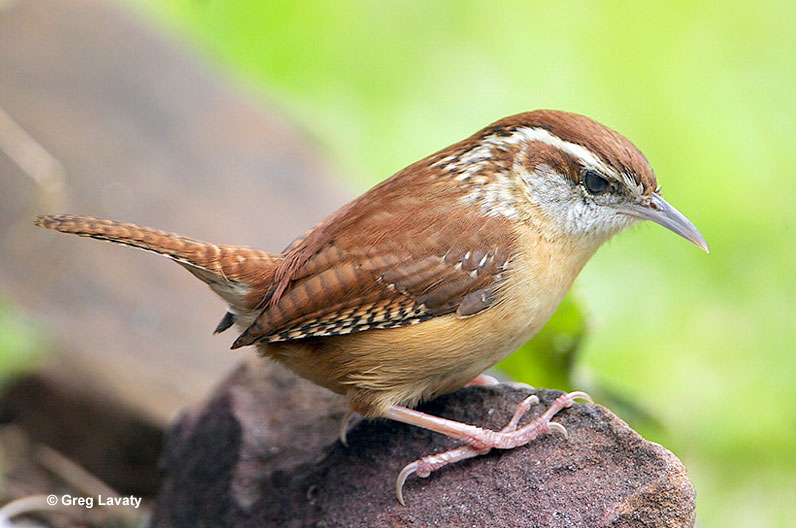
The Carolina Wren is a chunky yet small bird that has a round body and long tail that cocks upward. They have relatively large heads, small necks, and distinctive long, slender, downcurved bills. These birds are a little bit smaller than House Wrens.
Both females and males are unpatterned, bright reddish-brown above and warm buffy-orange below. Additionally, they have long white eyebrow stripes, white throats, white chins, and dark bills.
Carolina Wrens predominantly eat spiders and insects. Common foods they’ll consume include moths, caterpillars, stick bugs, beetles, grasshoppers, cockroaches, and crickets. In addition, they’ll occasionally eat snakes, frogs, and lizards. They also consume small amounts of plant matter like fruit pulp and seeds from poison ivy, sweetgum, and bayberry.
Blue Jay

© Alan D. Wilson
The Blue Jay is a large, common songbird with a large crest and wide, rounded tail.
Blue Jays are light gray or white underneath and various shades of white, black, and blue above.
Blue Jays eat grains, glean insects, and take seeds and nuts from shrubs, trees, and the ground. They’ve also been known to take injured and dead, small vertebrates. In addition, blue Jays are known to occasionally raid nests for nestlings and eggs.
Throughout the year, stomach contents have shown that about 22% of their diets are insects. Grains, acorns, fruits, and nuts make up the other 78%.
Barn Swallow
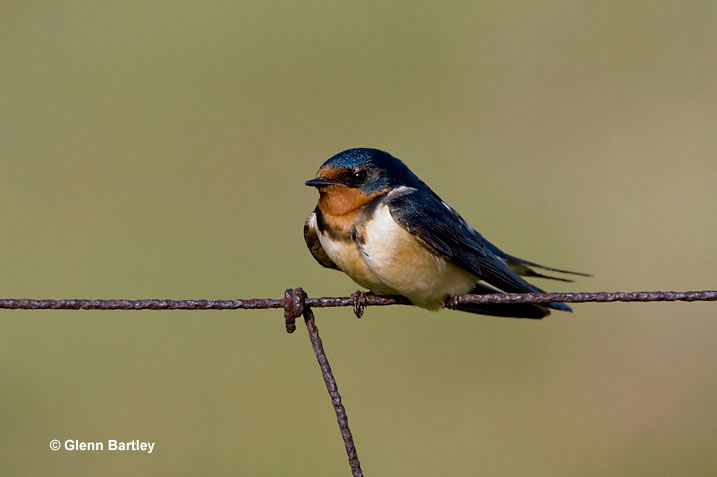
The Barn Swallow is a sparrow-sized bird with a slightly flattened head, broad shoulders, no visible neck, and pointed long wings. Their tails extend far beyond the wingtips, and their long outer feathers give their tails a deep fork. Barn Swallows are a little bit smaller than a bluebird.
Barn Swallows have rufous underparts and steely blue backs, tails, and wings. The face contrasts the blue crown beautifully due to the cinnamon-colored throat and forehead. White spots can be seen under the tail when these birds are in flight. Males are more vibrant than females.
Flies are the majority of the Barn Swallow’s diet. However, they’ll also consume bees, beetles, wasps, butterflies, ants, moths, and other flying insects. These birds take single, fairly large insects rather than feeding on large amounts of smaller prey. They’ve also been known to pick up small pebbles, grit, and even oyster shells and eggshells to help them digest their food or add necessary calcium to their diets.
Tufted Titmouse
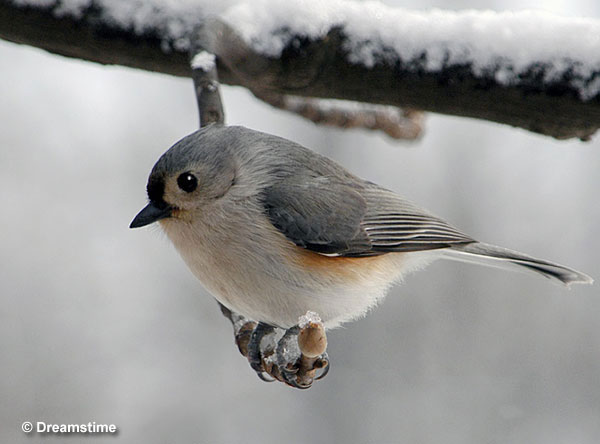
The Tufted Titmouse has a stout bill and noticeably pointed crest that helps identify these birds. They have large heads, large eyes, full bodies, and thick necks.
Tufted Titmice are white below and soft silvery gray above. Additionally, they have a peach-colored or rusty wash down their flanks. A black patch can be seen just above the bill.
Tufted Titmice mostly eat insects in the summer months, including beetles, caterpillars, wasps, ants, snails, and spiders. These birds also consume berries, nuts, and seeds, including beech nuts and acorns.
Northern Mockingbird
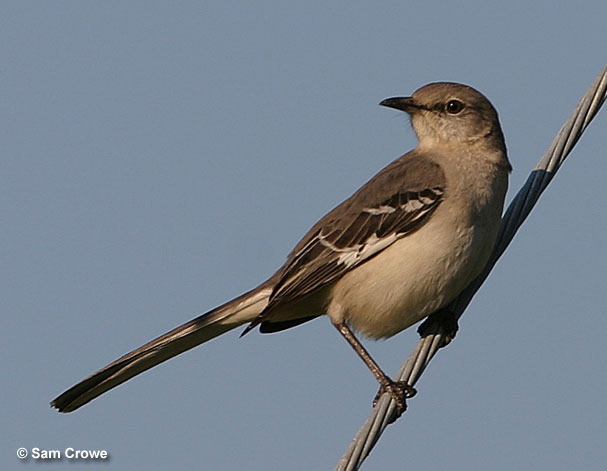
The Northern Mockingbird is a medium-sized songbird that’s slimmer than a thrush and has a longer tail. Additionally, these birds have smaller heads, long legs, and long, thin bills that have a hint of a downward curve. Their wings are rounded, short, and wide, which makes the tail look exceptionally long in flight. Northern Mockingbirds are a little bit bigger than Gray Catbirds.
Northern Mockingbirds are grayish-brown overall, have 2 white wingbars on each wing, and are paler on the belly and breast. White patches can be seen on the wings, which are easily seen on perched birds and birds in flight. The outer tail feathers are white as well.
Northern Mockingbirds primarily eat insects in the summer but switch to mostly consuming fruit in the fall and the winter. Some of the animal prey they consume are small lizards, beetles, moths, earthworms, ants, butterflies, wasps, and grasshoppers. They eat a wide variety of berries as well from ornamental bushes. They’ve even been seen drinking sap from recently pruned trees.
Red-bellied Woodpecker
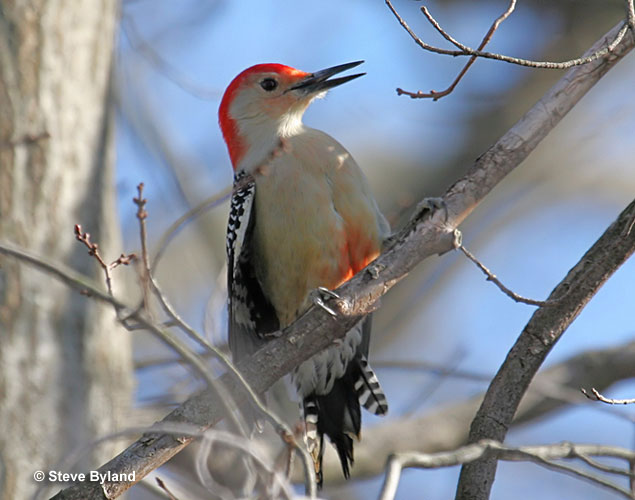
Red-bellied Woodpecker
The Red-bellied Woodpecker has a round head and is about the same size as a Hairy Woodpecker. Additionally, they lack the blocky outlines that Hairy Woodpeckers have.
These woodpeckers appear to be pale overall. However, they have a red nape, cap, and boldly black-and-white striped backs. Keep an eye out for the white patches near the wingtips as they fly.
Red-bellied Woodpeckers mainly consume spiders, insects, and other arthropods; they also eat plenty of plant materials as well. In New Jersey, they can be spotted snacking on nuts, acorns, pine cones, and seeds extracted from perennial and annual plants.
They also enjoy fruits ranging from hackberries, grapes, mangoes, and oranges. In addition, these birds will occasionally eat minnows, nestling birds, and lizards.
House Finch
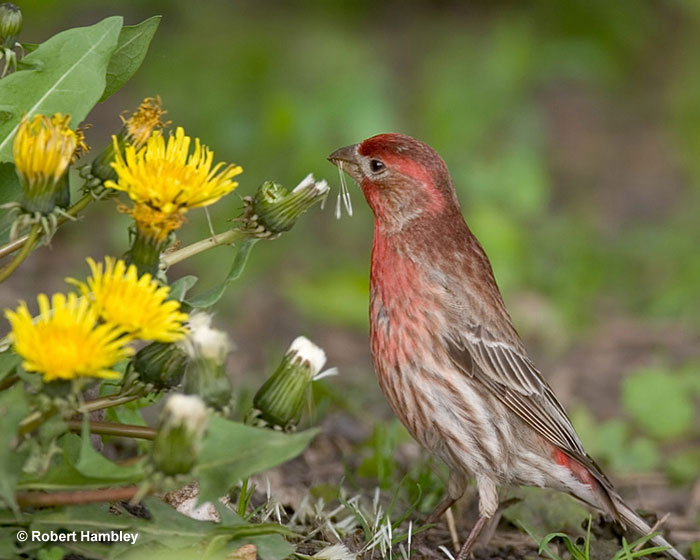
The House Finch is a small-bodied finch with relatively flat, long heads and large beaks. Their tails seem long due to the length of their wings. Unlike most finches, the House Finch has a fairly shallow notch in its tail. These birds are the same size as a House Sparrow but are more slender.
Adult male House Finches are rosy red around the upper breast and face. They have streaky brown tails, bellies, and backs. When in flight, their red rumps can be seen. Adult female House Finches aren’t red; they have thick blurry streaks and are plain grayish-brown overall. Additionally, they have indistinctly marked faces.
House Finches predominantly consume plant materials, including fruits, buds, and seeds. Some of the foods they’ll consume are knotweed, wild mustard seeds, thistle, poison oak, mulberry, and cactus.
In addition, House Finches consume apricots, cherries, peaches, plums, pears, blackberries, strawberries, and figs in orchards. House Finches will consume black oil sunflower over the milo, millet, and larger, striped sunflower seeds at bird feeders.
Cedar Waxwing
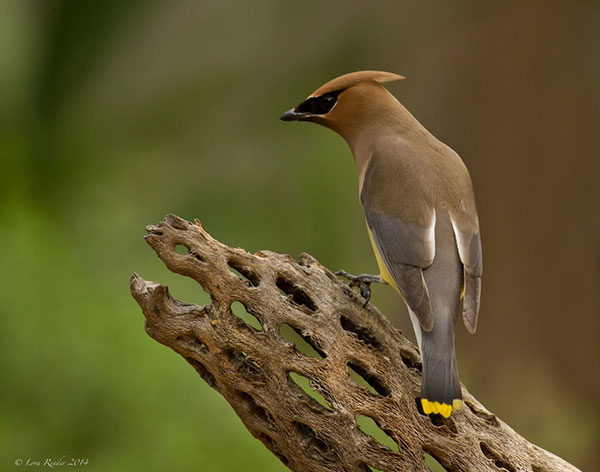
Cedar Waxwings are sleek, medium-sized birds with large heads, short necks, and wide, short bills. Additionally, they have a crest that usually lies flat and droops over the back of their head. Their wings are pointed, broad, and similar to a starling’s. Their tails are square-tipped and relatively short. These birds are a little bit smaller than a Bohemian Waxwing.
Cedar Waxwings have soft gray wings, pale brown heads, pale yellow bellies, and gray tails that have bright yellow tips. Their face has a slim black mask that’s cleanly outlined in white. The red waxy tips of their wing feathers are not easy to see.
Cedar Waxwings mainly eat fruits year-round. In the summer months, they feed on serviceberry, mulberry, strawberry, raspberries, and dogwood.
These birds got their name for their love of cedar berries that they usually consume in the winter. In addition, waxwings also consume madrone, mistletoe, juniper, honeysuckle, and mountain ash.
In the summer months, they supplement their diet with protein-rich insects, including dragonflies, stoneflies, and mayflies. These insects are often caught in flight.
Canada Goose
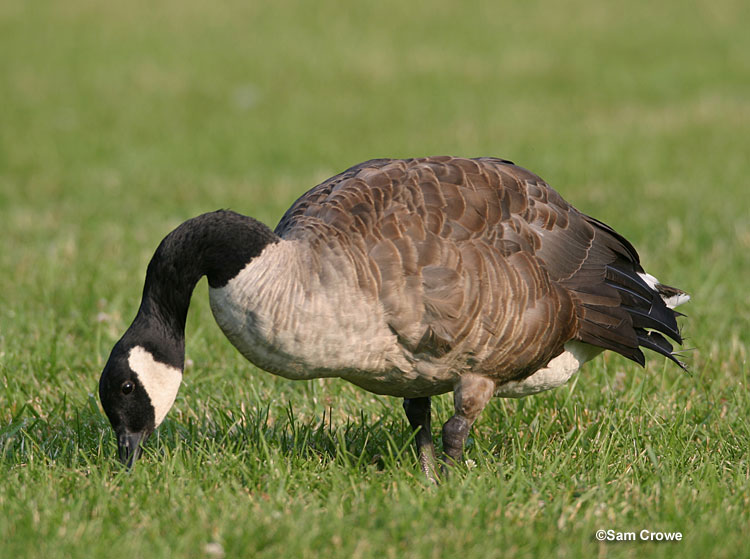
Canada Geese are large waterbirds that have large bodies, long necks, flat, wide bills, and large webbed feet.
They have brown backs, black heads with white cheeks and chinstraps, tan breasts, and black necks.
In the spring and summer months, Canada Geese concentrate on consuming sedges and grasses, including eelgrass and skunk cabbage leaves. During the fall and winter months, these birds rely heavily on seeds and berries, including blueberries and agricultural grains. Additionally, they’re very good at removing kernels from dry corn cobs.
American Goldfinch

© Alan D. Wilson
American Goldfinches are small finches with small heads, short, notched tails, and short, conical bills. These birds are smaller than a Tufted Titmouse.
Adult male American Goldfinches have black foreheads, black wings, white markings on their wings, white patches above and below the tails, and are bright yellow overall in the spring and summer. Female American Goldfinches are paler yellow below and olive above. In the winter, both males and female birds are drab, have blackish wings, two pale wingbars, and are unstreaked brown.
Goldfinches almost exclusively consume seeds. They prefer to consume thistle, sunflower seeds, asters, grasses, alder tree seeds, birch tree seeds, western red cedar tree seeds, and elm tree seeds. They are known to visit backyard bird feeders and prefer feeders filled with nyjer and sunflower seeds.
American Goldfinches are also known as New Jersey state birds.
Frequently Asked Questions about Birds of New Jersey
What is the most common bird in New Jersey?
The Northern Cardinal is the most common bird in New Jersey.
What are the rarest birds in New Jersey?
The rarest birds in New Jersey are White Pelicans, Cooper’s Hawks, and Pacific Loons.
Which birds stay in NJ in winter?
The birds that stay in New Jersey for the winter include Northern Cardinals, Mourning Doves, Downy Woodpeckers, Blue Jays, Red-bellied Woodpeckers, Tufted Titmice, and European Starlings.
What is the biggest bird of prey in New Jersey?
The biggest bird of prey in New Jersey is the Bald Eagle.
What birds are invasive in NJ?
The birds that are invasive in New Jersey are Rock Doves, Brown-headed Cowbirds, House Sparrows, House Finches, and Monk Parakeets.

